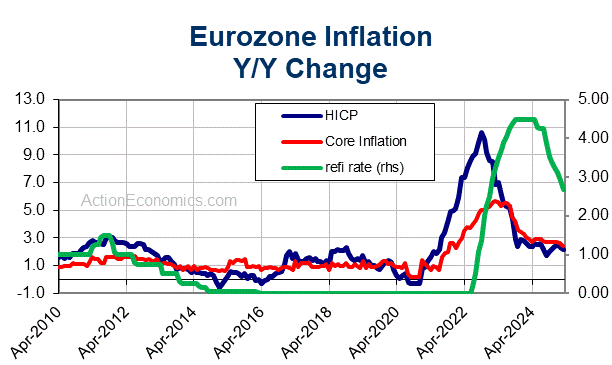It has been a rough road for the markets so far in Q4. The final quarter of the year has proven to be a challenging period for global financial markets. With lingering concerns over inflation, hawkish central bank stances, uncertainties in economic growth, and fiscal anxieties, both stocks and bonds have felt the strain. The recent escalation of tensions in the Middle East, particularly in the conflict between Israel and Hamas, has added another layer of complexity to an already volatile situation. As a result, market volatility metrics for both US stocks and bonds have soared, reflecting the apprehension of investors. Even though the immediate focus remains on the Middle East, attention turns on central banks.
The ECB, FOMC, BoE, and BoJ are just around the corner. All are expected to leave policy unchanged as they look to “proceed carefully” and try to avoid policy errors. Meanwhile, growth and inflation data also dominate global data calendars.
The ECB’s Dilemma
The ECB is widely expected to hold interest rates steady this week, adopting a hawkish hold that leaves room for future rate hikes while navigating uncertainties, such as the recent spike in oil prices and geopolitical developments. Those hoping for a dovish signal are likely to be disappointed. The central scenario rates are likely to have peaked, but of course the recent uptick in oil prices and developments in the Middle East mean uncertainty is still unusually high. In this situation the ECB is likely to keep its options open. At the same time, not even the doves are pushing for immediate rate cuts and the chances are that rate settings will remain unchanged through the first half of next year.
Officials are also expected to start the debate on the future of PEPP re-investments. These are currently set to run at least through to the end of 2024, but some officials have been flagging the need to end purchases before the central bank can consider rate cuts. We don’t expect a quick decision on this, but the prospect of an acceleration in quantitative tightening could well push out spreads, especially at a time when markets are already nervous.
Economic Challenges Persist
Recent data paints a concerning picture. Growth rates are slowing, and although inflation might have peaked, it remains above target levels. The Eurozone, in particular, faces economic headwinds.
More precisely, the HCOB flash PMI report for the Eurozone was pretty disappointing. The Services PMI declined to a 32-month low of 47.8 in October. The Manufacturing Output Index held steady at 43.1, while the Manufacturing PMI fell to a 3-month low of 43.0. It was not a great report. National data show somewhat diverging developments, as in Germany manufacturing sentiment improved, while in France it was the services sector that was less gloomy than in the previous month.
The HCOB flagged that across the economy new orders fell at an accelerating rate, which is pointing to a worsening demand environment for goods as well as services. The rate of inflation moderated slightly and is at its lowest since February of 2021. At the same time, firms reduced employment levels for the first time since January of 2021, which adds to signs that the overall economic environment is deteriorating and that wage growth is likely to slow as the labour market loosens.

Additionally, consumer confidence in Germany hit a seven-month low, influenced by rising food and energy prices. The advance reading for November came in at -28.1, down from 26.7 in October. Expectations had been for a slight improvement, so it was another disappointing result with rising food and energy prices continuing to weigh on confidence. At the same time higher interest rates are boosting the propensity to save, which according to the survey is at the highest in over a decade. The numbers tie in with the -0.1 point drop in the Eurozone consumer confidence reading, which came in at -17.9 in October.
Market Response
EURUSD tried to nudge past the 1.06 mark over the past week, but heightened risk aversion and expectations for unchanged policy rates meant the pair essentially moved sideways. The USDIndex continues to benefit from safe haven demand if and when risk appetite wanes. With markets keeping a wary eye on the Israel-Hamas conflict, even hawkish comments from Lagarde on Thursday may not boost the EUR lastingly.
As global markets navigate stormy seas marked by geopolitical tensions and economic challenges, central banks find themselves in a delicate balancing act. The need to address inflation while supporting economic growth and stability remains paramount. Investors, meanwhile, are advised to remain vigilant, as uncertainties persist, shaping the trajectory of financial markets in the coming months.
Click here to access our Economic Calendar
Andria Pichidi
Market Analyst
Disclaimer: This material is provided as a general marketing communication for information purposes only and does not constitute an independent investment research. Nothing in this communication contains, or should be considered as containing, an investment advice or an investment recommendation or a solicitation for the purpose of buying or selling of any financial instrument. All information provided is gathered from reputable sources and any information containing an indication of past performance is not a guarantee or reliable indicator of future performance. Users acknowledge that any investment in Leveraged Products is characterized by a certain degree of uncertainty and that any investment of this nature involves a high level of risk for which the users are solely responsible and liable. We assume no liability for any loss arising from any investment made based on the information provided in this communication. This communication must not be reproduced or further distributed without our prior written permission.
